Do you want to learn how to write a great blog post with ChatGPT? Welcome, this guide is for you.
Blogging is an excellent way to share your passion with others while earning money on the side, but writing blog posts that score every time isn’t a walk in the park. It can take you anywhere between 4 to 8 hours to write a 1500-word blog post depending on the complexity of the topic and your expertise.
The days of that drudgery, however, now seem to be a thing of the past, thanks to ChatGPT.
ChatGPT is an AI-powered Chatbot that can perform a variety of tasks, blog writing being just one of them. Not only can it write full-length blog posts with an introduction, an outline, and a conclusion but can also help you with writing a click-worthy headline and a killer meta description.
In this article, you will learn how to leverage ChatGPT to 10x your productivity in blogging, how to make its content pass the AI detection test, and how to write blogs that look like they were written by a real person.
Let’s dive in.
When NOT to write a blog post with ChatGPT
ChatGPT is a godsend when it comes to writing blog posts, but it’s not perfect.
There are a few things where ChatGPT falls just short of doing a flawless job.
One-shot blog posts
If your idea of using ChatGPT is to write blog posts in one single command, you are in for a shock.
The content pumped out by ChatGPT, without much human intervention is generic and formulaic, not to mention that it can be easily caught by AI detection tools such as Originality AI.
Take, for example, the following blog post (titled: “Is Bitcoin a Scam? 5 Things That Prove It”) that I generated using ChatGPT in one shot:

I fed this output to Originality AI, an AI content detection tool, which caught it right away.
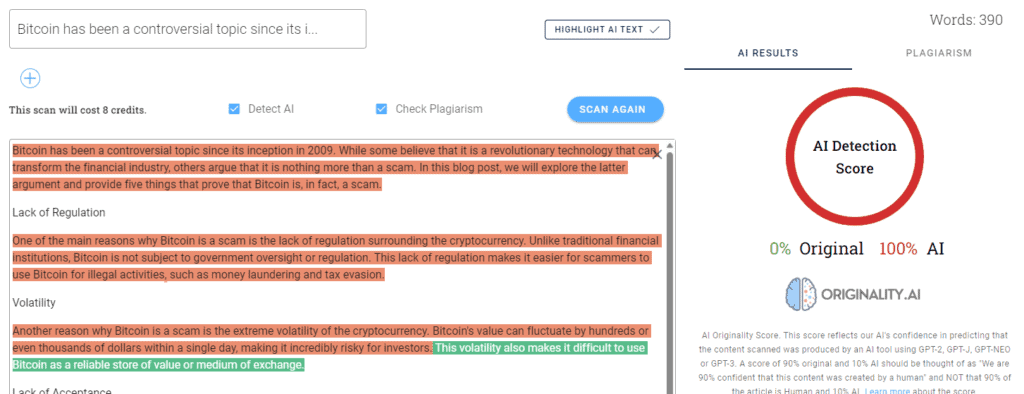
Originality AI flagged this blurb as 100% AI and 0% human.
Surely, you don’t want that for your blog posts. If a tiny fledgling tool like Originality.ai can spot it, Google certainly can.
What if your competitors are also using ChatGPT to write their blog posts? What’s different about your article then? It’s not gonna rank on Google with thousands of people using ChatGPT to churn out dry content like this.
AI detection is not the only problem with one-shot blog posts. There are a few blog types that are better served by human writers, especially Reviews and Tutorials.
Reviews and Tutorials
I never write reviews or tutorials using ChatGPT. That’s too sacred a space to let an AI creep into. It is a territory that I do not want to cede to AI tools.
I write reviews based on my actual experience with the product. Readers rely on my first-hand account of the product, and I take that responsibility seriously. And using AI tools to write product reviews is dishonest and a surefire way to lose your reader’s trust.
Similarly, when it comes to writing tutorials, there is no AI tool that is specialized enough to convey what I have learned during my tinkering and fiddling with a product. A computer program can’t do a good job of imitating the depth of understanding that comes from doing something for yourself.
Also, tutorials such as Adobe Photoshop or Illustrator often require screenshots to get your point across. ChatGPT is, at least now, purely text-based. There’s only so much you can teach using utterly text-based tools.
In the same vein, ChatGPT isn’t the perfect companion when you are writing about something that requires specialized knowledge.
Things/events after the cut-off date
As of 10th April 2023, ChatGPT has been trained on data only up to September 2021.
It has a limited understanding of the events that happened after this cut-off date. So, it cannot be relied upon to write about things or events that happened after this date.
Keyword research
Lots of people on social media sites have looked into how ChatGPT could be used for keyword research, and some have even suggested it for your blog.
But I strongly disagree with using ChatGPT for any kind of keyword research. Keyword metrics change almost every day, and only a specialized tool like SEMrush or Ahrefs can give you reliable data that will help you make an informed decision.
The biggest flaw in ChatGPT that cripples it for any kind of keyword research is its inability to access any real-time data. It is still limited by its cut-off date which makes it unsuitable for keyword research.
When to use ChatGPT to write blog posts
There are, however, a few categories of blogs that can be written by ChatGPT pretty convincingly. Most of these blogs are pretty generic and do not require any specialized knowledge.
The following types of blog posts written by ChatGPT are passable after some editing and jazzing up:
- 7 Benefits of cycling
- How to stay focused while working on a project
- How to learn coding in 3 months
- What is NFT? Explained with 3 examples
- Things to know before buying a gaming monitor
These kinds of blog posts are pretty thin in content which users can easily skim. ChatGPT does a good job of writing such superficial content. Also, as they do not require any screenshots or images to convey their meaning, ChatGPT isn’t ill-equipped to write them.
How to write a blog post with ChatGPT
A blog post has several components and ChatGPT can help with most of them. Usually, when writing blog posts, you will have to do the following:
- Write a headline
- Write a meta description
- Write an introduction
- Generate an outline
- Flesh out the headings and subheadings in the outline
- Write a conclusion
Let’s cover them step by step:
1. Write a headline
Your headline is the first thing that readers see when searching on Google. It’s crucial that they entice readers and hypnotize them into clicking your article.
ChatGPT can write great click-worthy headlines for you. You simply have to give it a simple command:
I am writing a blog post on “Is Bitcoin a Scam? 5 Things That Prove It.”
I want you to write 10 click-worthy headlines for this blog post.
ChatGPT will come up with some great headlines for your title, but there’s more to it than just asking it to write headlines.
There are a few tips that you can use to jazz up your headlines.
1. List posts perform better than others
You can use ChatGPT to write headlines for listicles. You can use this prompt:
I am writing a blog post on “Is Bitcoin a Scam? 5 Things That Prove It.”. Write me some listicle style headlines for my blog post. Use odd numbers only.
Also, some studies have found that odd numbers work better than even numbers in headlines. Even numbers look symmetric and regular so they don’t stick out as often as odd numbers which look wonky and notably different.
2. Use punchy adjectives
A headline devoid of any adjectives looks lackluster whereas a headline with a weak adjective looks dull.
Check out the following three headlines:
— 7 Tips to Make Your Writing Better
— 7 Cool Tips to Make Your Writing Better
— 7 Mind-blowing Tips to Make Your Writing Better
Most people will click on the third title because it promises just a little more and triggers the reader’s mind psychologically.
You can use the following prompt to generate headlines with punchy adjectives:
I am writing a blog post on “Is Bitcoin a Scam? 5 Things That Prove It.”. Write me some headlines for my blog post.
The headlines must use attention-grabbing adjectives such as “mind-blowing”, “eye-popping”, “jaw-dropping” etc.
I have also written an entire blog post on tips to skyrocket the clickthrough rate of your headlines. In this article, you will also find a list of weak adjectives that you can replace with stronger ones.
3. Use stronger, more intense verb
Along the same lines as point #2 above, headlines pop out more when they are fueled by a stronger, more visceral verb to get their point across.
For example, take a look at the following two headlines:
— Use This Trick to Drastically Increase Your Website Traffic
— Use This Trick to Skyrocket Your Website Traffic
The presence of the verb “skyrocket” in the second headline makes it 10 times more alluring to the reader.
You can use the following prompt in ChatGPT to generate such headlines:
I am writing a blog post on “benefits of cycling for women over 40”. Write me some headlines for my blog post.
The headlines should use strong verbs such as “accomplish”, “achieve”, “master” etc. An example of such a headline can be “achieve maximum fitness using cycling if you are a women over 40”.
If you want more tips, you might want to check out my article titled 13 Insane Hacks to Write Great Headlines with ChatGPT.
Now that we have written a great headline for our blog post, it’s time to write a captivating meta description to hook the reader in.
2. Write a meta description
The meta description of your blog post is the nearly 150-character long blurb that appears just below your headline on the Google search results page.

It’s the second most important thing after your headline that lures your reader in. If you don’t write a meta description of your blog post, Google extracts a relevant part of your blog post and shows it below the headline.
You don’t want to leave things to Google. Make sure you write meta descriptions for all your blog posts.
A great meta-description is concise, relevant, compelling, and persuasive.
You can try this prompt to write a meta description for your blog posts:
I am writing a blog post on “Is Bitcoin a Scam? 5 Things That Prove It.”
I want you to write ten 150-character long meta descriptions for this blog post. Make it pursuasive and compelling. Use a few short, pointed, punchy questions to capture the reader’s problem and then offer this blog post as a solution.
Here’s the output:
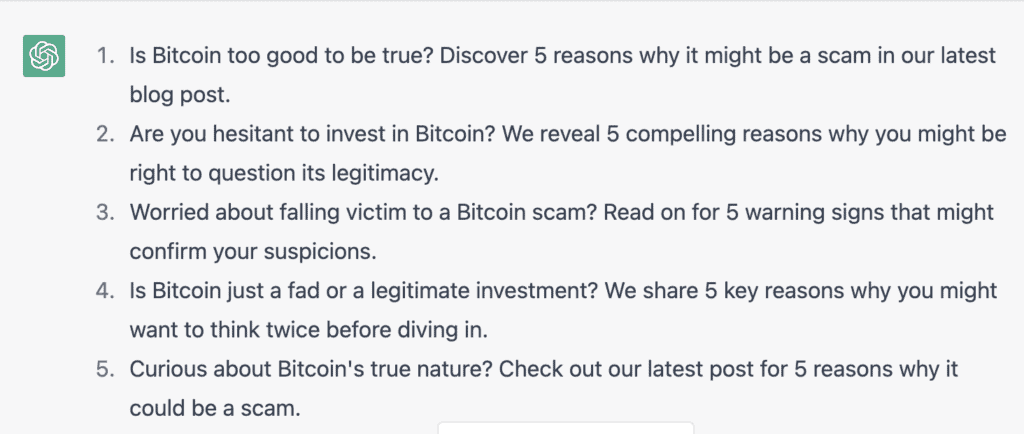
You can even ask ChatGPT to write meta descriptions using the Problem-Agitate-Solution (PAS) framework. I tried it and this was the result:
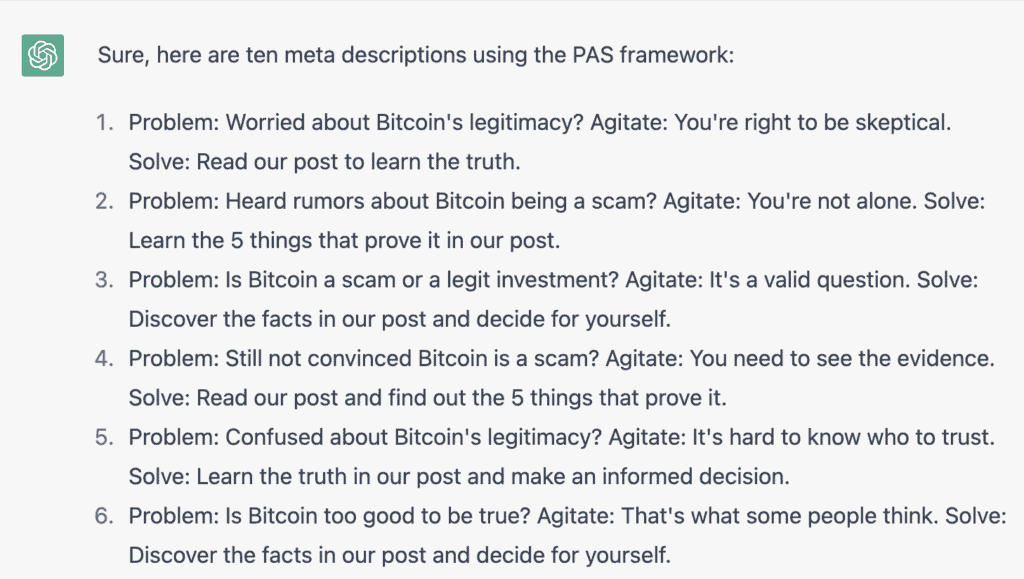
Pretty neat!
3. Write the Introduction
Now that we are done with the headline and the meta description, it’s time to get into the meat of the problem: the actual blog post.
The introduction to the blog post must be captivating and hooking. Remember, the average attention span of today’s readers is just 8 seconds. If he is bored within the first 8 seconds, he will immediately go back.
You can use this command to write a compelling introduction with ChatGPT:
I am writing a blog post on “Is Bitcoin a Scam? 5 Things That Prove It.”
I want you to write a captivating introduction for this blog post. The introduction must lay out the problem before the reader, and then promise him that he will find the solution he is seeking in this blog post.
This prompt works great but you can always vary it according to your needs.
Make sure that the introduction is not too long. Strive to get to the main points of your blog as soon as possible.
4. Generate an Outline
The next step is to generate an outline for your blog post.
If you already have a skeleton of your blog post in your mind, great. You can ask ChatGPT to write sub-headings for your headings.
I am writing a blog post on “5 Reasons Bitcoin Might be a Scam.”
I have so far this outline for headings: 1. Evidence from the US military 2. Proof from the leaked white paper that was kept secret 3. Sudden rise of NFTs 4. Lack of a figure-head behind Bitcoin 5. Bitcoin being a deflationary currency
I want you to write 3 sub-headings for these headings. Make sure to write only the relevant sub-headings that actually complement the heading and tie all things up. Go.
Even though I wrote these headings on a whim, ChatGPT did a good job of coming up with convincing sub-headings that didn’t need much editing and pruning:
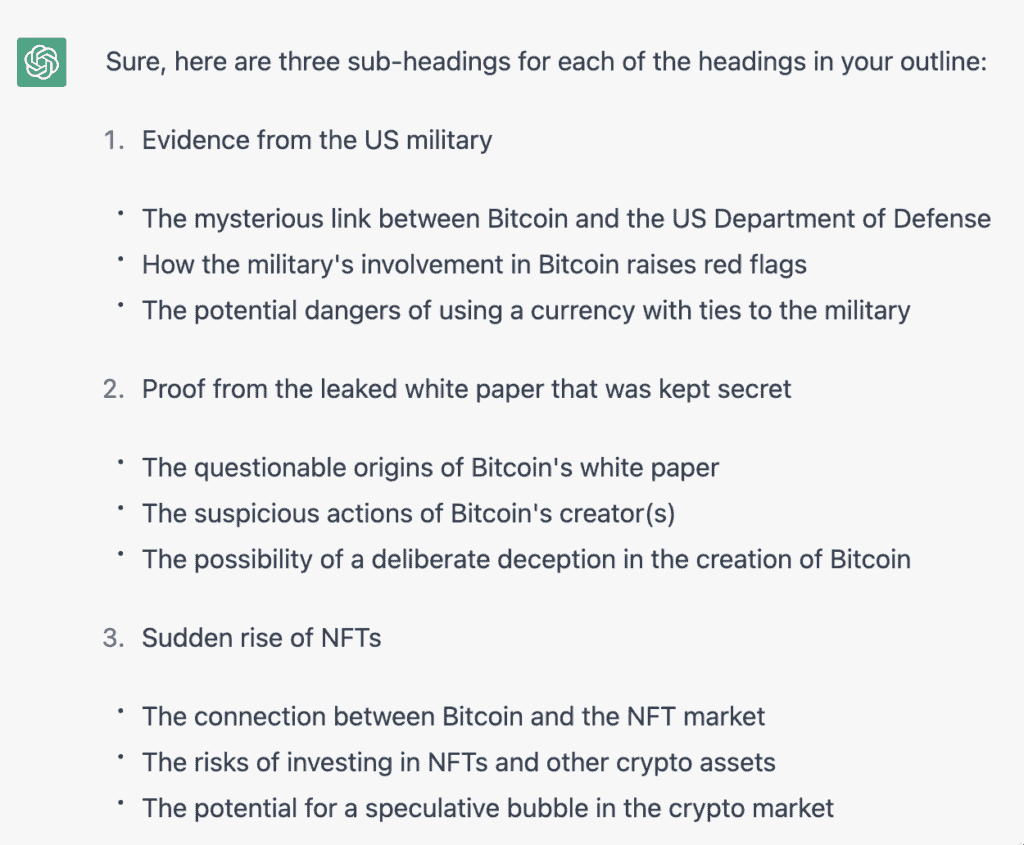
If you don’t have a headline in your mind, that’s not a problem either.
ChatGPT can write an outline for your blog posts. You can even specify how many headings and sub-headings you want. A simple prompt works best here:
I am writing a blog post titled “5 Reasons Bitcoin Might be a Scam.”
I want you to write a 5-point outline with 3 sub-headings each.
As a rule, you should always generate more content than you need. This way, you have the freedom to edit it and trim it down to your requirements.
5. Expand upon the sub-headings
Now that you have generated an outline, it’s time to flesh out the details. You can simply ask ChatGPT to write two paragraphs about each sub-heading:
I am writing a blog post titled “5 Reasons Bitcoin Might be a Scam.”
One of the sub-headings is “_________________”. I want you to write two paragraphs about it.
The preceding sub-heading is “___________” and the next section is titled “______________”.
Make sure that the paragraph flows from the preceding one and naturally leads to the next section.
You can use this prompt repeatedly to generate two (or more) paragraphs for each of your sub-heading.
Remember, you should generate more content than you will include in your final output because you will edit and prune it ruthlessly to make it human-like.
We will see how to make it human-like in just a short while.
6. Write a conclusion
Once you have expanded on the headings and sub-headings, it’s time to write a conclusion for your blog post.
Just like we asked ChatGPT to write an introduction, we can ask it to write a conclusion.
One of the things I like to do while writing conclusions is to give ChatGPT my outline (bullet points) and then ask it to write a conclusion:
I am writing a blog post on “5 Reasons Bitcoin Might be a Scam.”
I have covered the following bullet points in my blog post:
1. ______________
2. ______________
3. ______________
4. … and so onI want you to write a conclusion for this blog post. Make sure to tie up all points together.
This trick works every time.
How to make AI text look human
Up until now, whatever you have generated has been written entirely by ChatGPT.
It has two major problems:
- It looks bland and dry: The text written by ChatGPT is produced in a matter-of-fact tone, which is barren of any personal experiences, biases, or human touch. It feels like you are reading a Wikipedia article or a news report.
- It doesn’t pass the AI-detection test: As the text so far has been spun entirely by AI, it still won’t pass Originality’s AI-detection test.
The text so far is bloated and dull. It’s time to edit it and bring it down to our desired length.
How to spice up AI text
- Use contractions: Use contractions. People often use contract words such as “can’t,” “won’t,” “shouldn’t,” etc. These contractions make your writing natural and conversational.
- Vary sentence length: Vary the length of your sentences. Shorter sentences are great for emphasis, while longer ones help to provide context or explanation.
- Ask questions: Intermittent questions create a sense of dialogue between the writer and the reader, making the writing more personal to the reader.
- Use anecdotes: Personal anecdotes or stories helps readers visualize themselves in the shoes of the writer, thus establishing a connection between the two through words.
- Use transitional words: Transitional words and phrases (e.g. “however,” “therefore,” “meanwhile”) can help to create a more natural flow between sentences and paragraphs. This one is a biggie, so let’s expand upon it a bit more.
Use transitional words
Transition words are the glue that connects your sentences and ideas together. They make sure your thoughts flow smoothly from one sentence to the next.
“First,” “next,” “then,” “finally”, “also”, “however,” and “meanwhile” are all examples of transitional words. These words help you show the order of events, compare two different viewpoints, or add more information to what you are saying.
Imagine for a moment that you want to add more evidence to support your point of view. You can start your next sentence with “furthermore”, “moreover”, or “similarly”. But if you want to show a contrasting view, you can use “however”, “on the other hand”, or “although”.
These transition words are way more important when we’re using AI writing tools. We can use them to guide the AI to write in a specific direction.
Here are some more examples of transition words:
Addition — Additionally, also, furthermore, moreover, in addition, as well as, likewise, similarly
Contrast — However, nevertheless, on the other hand, nonetheless, although, even though, despite, in spite of
Time — Meanwhile, in the meantime, subsequently
Cause and Effect — As a result, consequently, therefore, thus
Conclusion — In conclusion, finally
How to use transition words/phrases to level up your blog post
Now comes the fun part. You can make your article ten times more engaging and human-like if you used transition words. And yes, you can use ChatGPT to help you with these tasks.
Below are the things you can do to your article with transition words:
1. Present evidence or supporting material
After you have ChatGPT write the article for you, scrutinize it. Look for any claims or viewpoints that are hanging without any proof or evidence. It’s time to make ChatGPT come up with some solid evidence to back up its views and make them more believable.
The trick is simple: take an argument that ChatGPT has made in the article and ask it to expand on it. But before giving the command, append phrases like “It’s been proven by…” or “Recent research shows…” or “It’s been evidenced in…”.
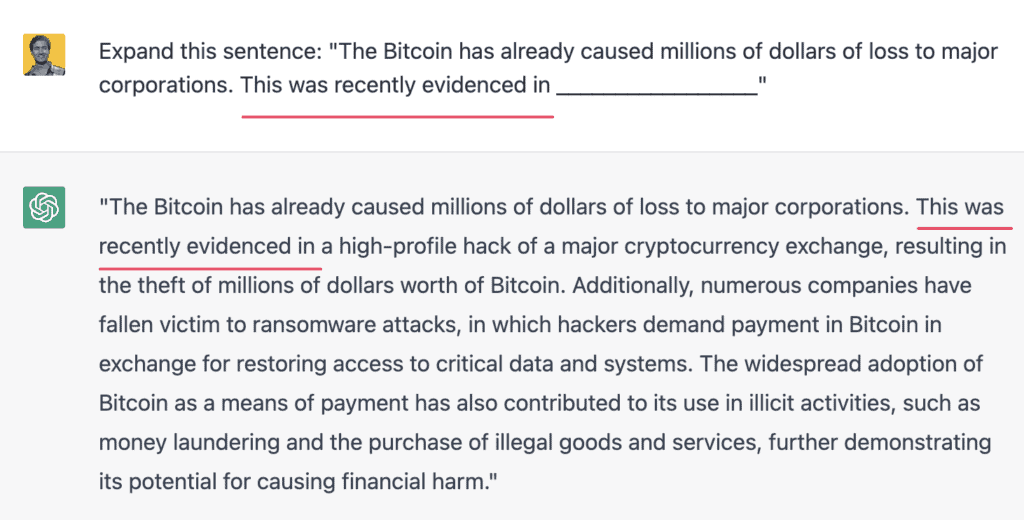
Sweet!
2. Present counterarguments
If you believe there might be some objections or concerns in the manner you have read into the evidence or if the evidence can be worked out in more than one way, make sure to present counterarguments too.
You can append these phrases to get some counterarguments out of ChatGPT: ‘On the other hand’, ‘However’, ‘Whereas’ etc.
3. Give examples
One example replaces 10 sentences of explanations. Give examples as much as possible to clearly lay out your reasoning.
Phrases like ‘For example’ or ‘For instance’ will suffice to get you some nice examples.
I have written more about it in this article on writing great essays with ChatGPT.
Use a Paraphrasing tool
The article you have so far is much better than what ChatGPT would have written on its own, but it’s still not perfect.
Every piece of text that AI tools like ChatGPT write has its “watermark.” The pattern in ChatGPT-written content is easy to spot for AI detection software that has been trained on the same language model.
If you run your article through Originality AI, it will likely be flagged as AI-generated (because it is).
To avoid getting caught by AI, we have to mix things up by switching up some words or rewording things a bit.
One way to do this is by doing it manually. You paste your article into a free writing tool like Grammarly or Hemingway App and edit it ruthlessly.
Another but more efficient method is to use a paid tool like Quillbot.
Quillbot is a paraphrasing tool that uses AI to rephrase your sentences. Other than paraphrasing, it also has a few other features such as a grammar and plagiarism checker, co-writer, Summarizer, and Citation Generator.
It can rewrite your content in 5 different ways: Standard, Fluency, Formal, Simple, and creative. To rewrite your article, you would want to stick either with the Standard mode or with the Fluency mode.
The best thing about Quillbot is that it can fool leading AI detection tools like Originality AI. I did a case study where I got ChatGPT to write 10 blog posts across different niches.
First, I fed them all verbatim to Originality AI, which caught 7 of them right away. Then, I paraphrased all the blog posts using Quillbot, and to my surprise, both Originality AI and Writer.com failed terribly. You can read about that case study here.
Quillbot’s subscription costs $9.99 for a monthly plan, $6.66 for the 6-month plan, and just $4.17/month ($49.95/year) for the annual plan. You can paraphrase an unlimited number of words in each plan.
If you only have an occasional need, you can get by with the monthly plan but if you are going to need it often, a semi-annual or annual plan will be much more cost-effective.
You can buy the Quillbot subscription here.
Conclusion
In the end, ChatGPT can be a helpful tool for bloggers who want to make content quickly and easily. But you should know when not to use it, like for one-time blog posts, reviews, or tutorials.
When using ChatGPT to write blog posts, it’s important to follow the right steps, such as writing a headline, meta description, introduction, outline, subheadings, and conclusion.
Finally, we discussed how o make AI text seem more human. Remember, transition words are your friend. By adding these words to your blog post, you can take it to the next level and make it more interesting to read.
Remember that AI traces are hard to remove from AI content, so you might need a specialized tool like Quillbot to paraphrase your content and pass the AI detection test.
With these tips, you can get the most out of ChatGPT and create high-quality content that your readers will love.
Further reading: